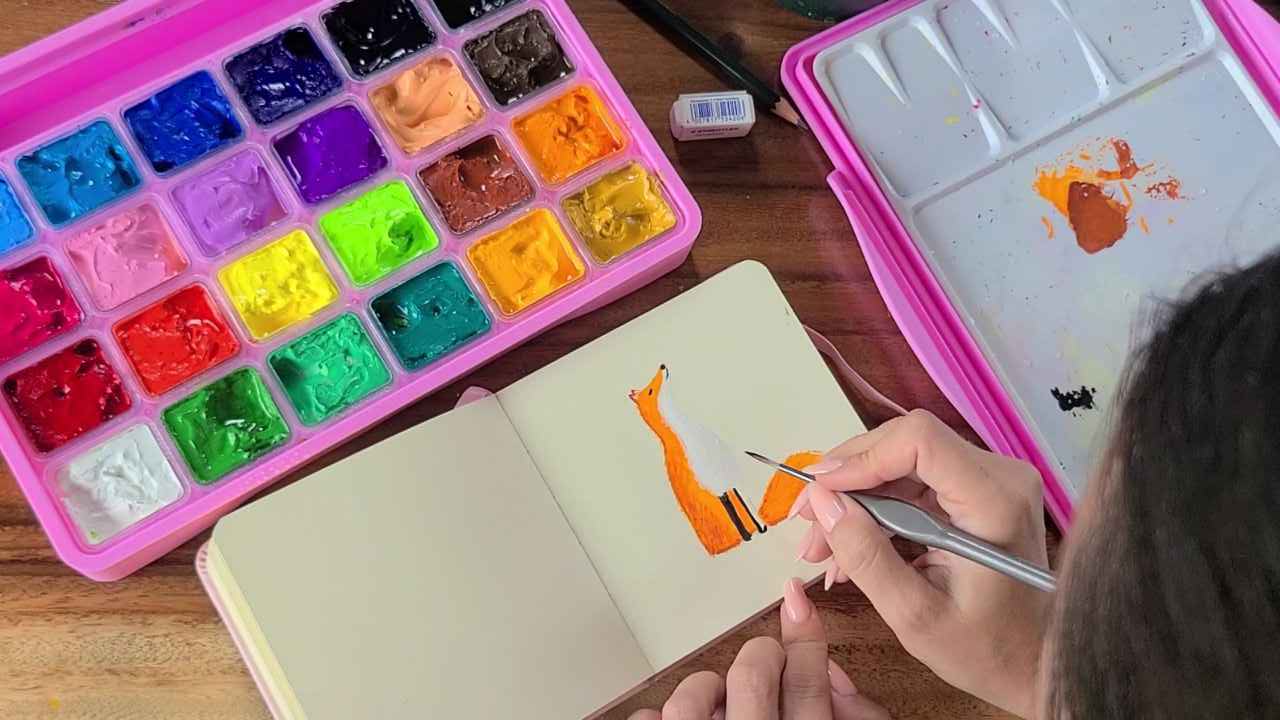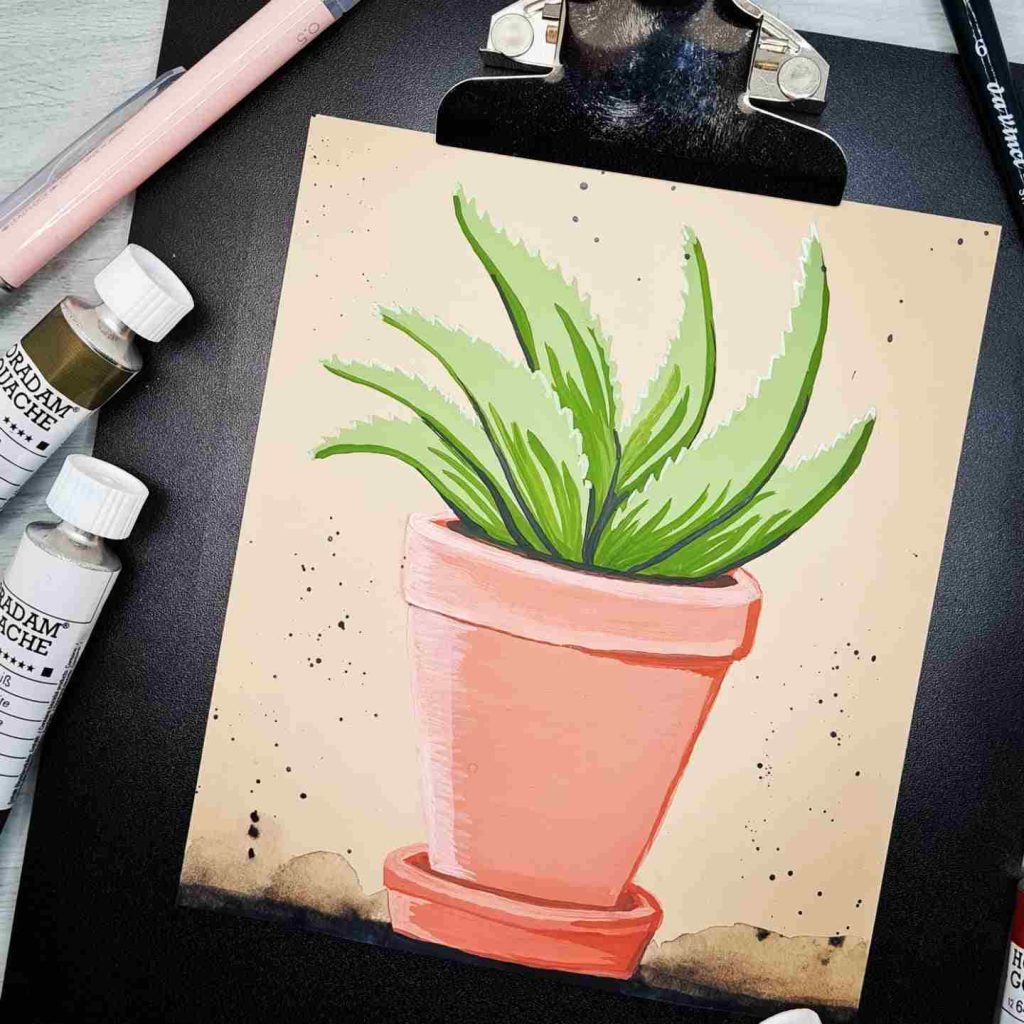Last Updated on March 27, 2024 by Masha Eretnova
When you get to learn how to paint with Gouache, its fundamentals, and various gouache painting ideas and techniques, there is no doubt that this paint will be easy for you to use as it is beginner-friendly as well.
Some of the Gouache Painting Ideas for beginners include food illustrations, landscapes, cloudy skies, starry nights, and motivational posters. For those who are seeking advancement, you can try to copy famous Gouache Paintings such as Freshwater Pond by Ned Seidler and Marine Painting by Carl Evers or try painting portraits.
Many artists get art blocks as they go throughout their journey, so we are here to help you think of a nice and easy idea of what to paint using Gouache paint as a beginner. You could always use and look back on these Gouache paint ideas as a starting point for your future paintings.
Table of Contents
Essential Art Supplies to Paint with Gouache
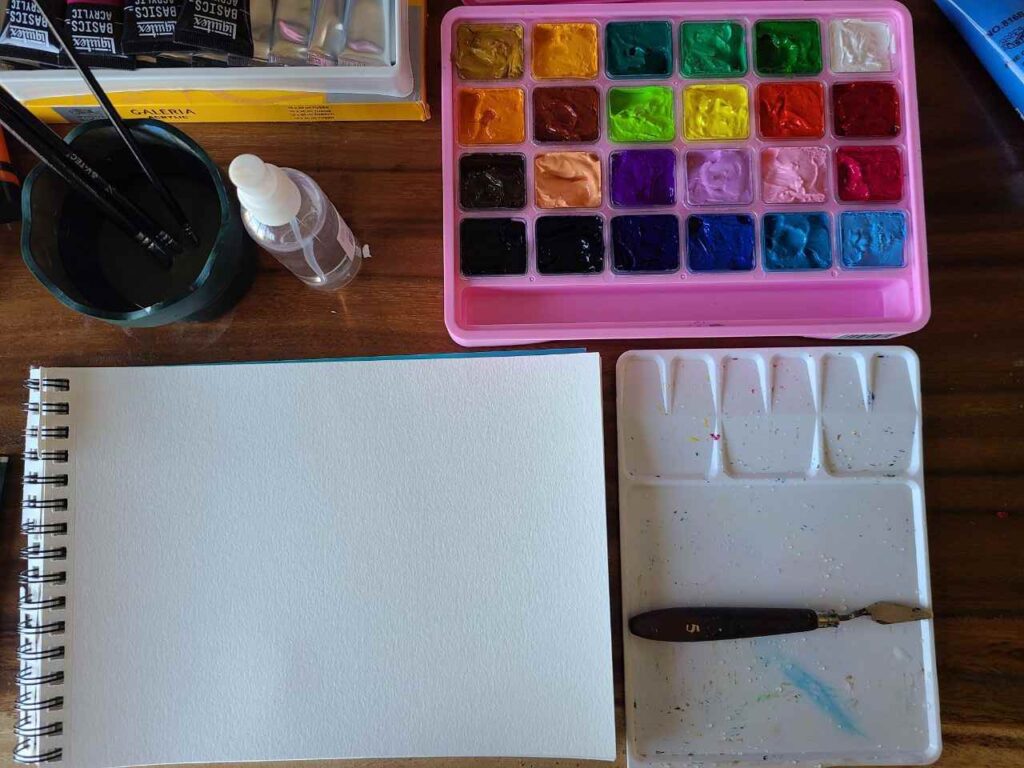
Before diving into the beautiful world of Gouache paint, make sure you have all the essential tools and supplies needed to get going. Gouache is a very forgiving medium and you can have fun creating art with just a few brushes and paints.
And because Gouache only needs minimal supplies, your tools may be different than when you use acrylic or watercolor paint as media.
- gouache paint
- gouache brush set (I recommend synthetic brushes)
- water (in a jar and spray bottle)
- paper towel
- canvas or watercolour paper, other surfaces may work but the paper is the best for gouache
- *palette knife (I use for mixing paint!)
Check also: Painting with Gouache for Beginners: 7-Step Ultimate Guide
Gouache Paints
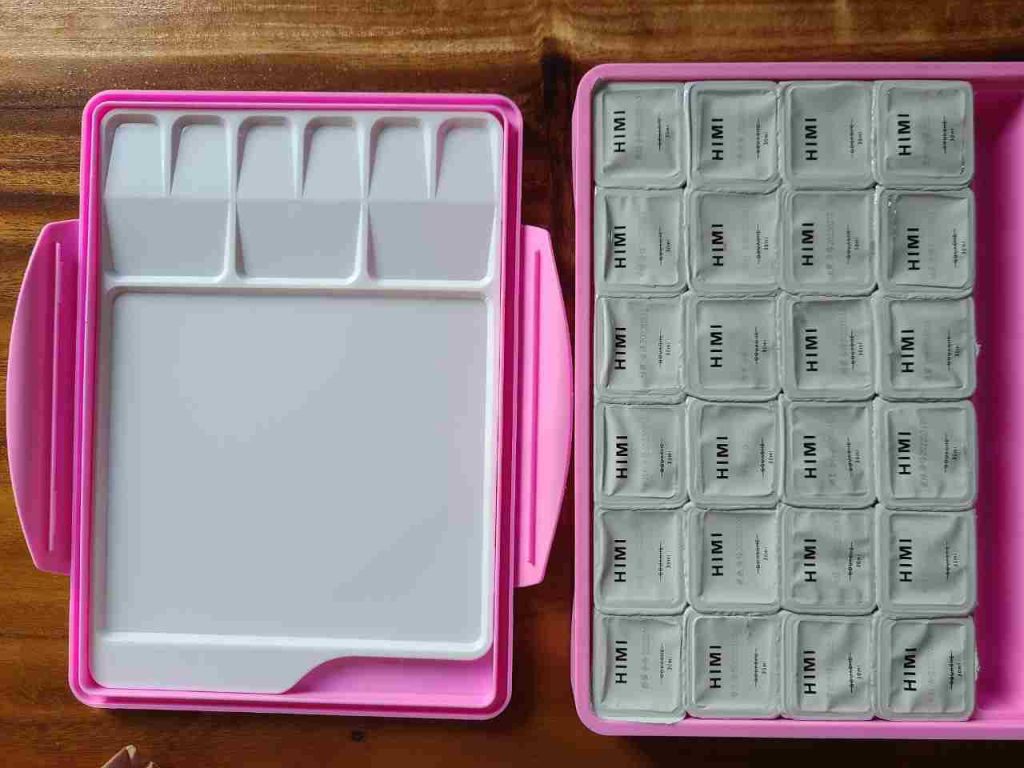
Many artists refer to Gouache as “opaque watercolor” because it contains a pigment combined with a binding agent like watercolor. However, the medium’s tint has a greater quantity and is paired with a solid pigment which feels closer to acrylic paint.
Choose your best one with my comprehensive guide: 15 Best Gouache Paint Sets in 2022 For Beginners and Pros
Brush
Beginners only need 3 brushes for painting; small, round, and broad (flat or filbert). They have total freedom over what they want to paint with different brush types.
Synthetic watercolor or acrylic brushes are highly recommended for gouache paint because of their soft texture. The fluidity gives the color a delicate stroke.
Always remember that you must clean it with water after painting with gouache. The substance that makes it opaque could potentially damage your brushes when it dries.
Pick your perfect brush set from my list of 19 Best Brushes for Gouache Reviewed by Artist [Ultimate Brush Guide]
Painting surface
Gouache is so flexible you can use it on most surfaces and it works more like acrylic paint.
Artists can start with watercolor paper, an illustration board, or thick drawing paper. However, gouache doesn’t work as well as acrylic on canvas in terms of creating textures or layering.
Palette
For palettes, it is recommended to use non-absorbent ones such as plastic or ceramic for easier cleaning since Gouache only needs water. People like using palettes with little wells if you will add water to paint.
I prefer flat palettes as I use very little water but I find it hard to get all paint out of the well haha 🙂
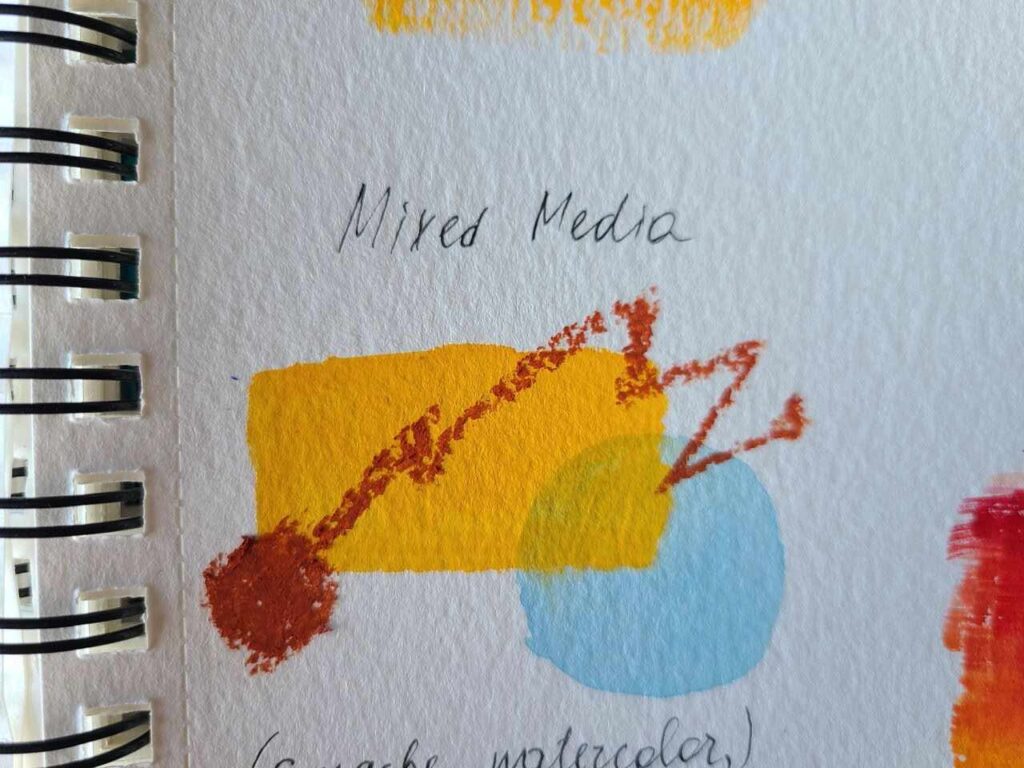
Read also: Gouache Vs Acrylic: What’s the Difference, and Which is Best for Beginners?
Gouache Painting Ideas for Beginners
Some artists get excited when they start to paint to the point they don’t know what they want to try next, so we prepared a list for you to look at when you have no idea what to paint.
Technically gouache painting ideas are NO different from acrylic painting ideas and you can easily paint something others do with acrylics with your gouache paint.
The only exceptions would be the impasto technique, pouring, or oil imitation.
Learn more: 18 Gouache Painting Techniques You Should Try To Paint Like Pro
So for more ideas please dig in:
- Spring Painting Ideas
- Easter Painting Ideas
- Fall Painting Ideas
- Winter & Christmas Painting Ideas
- 101+ painting ideas
- Star Wars Painting Ideas
Each idea listed below is beginner-friendly and easy, even for inexperienced painters. If you want to know more about Gouache paint ideas, read more below:
Gouache landscapes
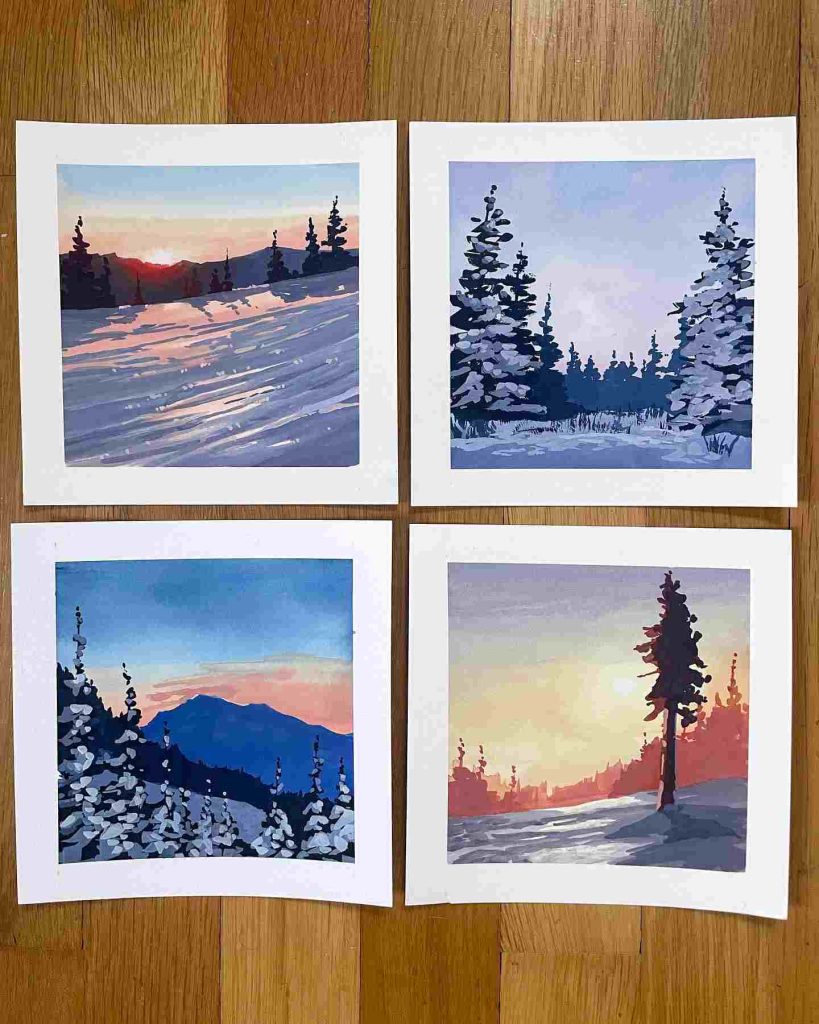
- Artists can use Gouache paints to create striking landscapes, scenery, or skyline art.
- It is recommended to use dreamy pastel colors for the sky for a more attractive look.
- As you can see, you can spot the brushstrokes and you can tell that this is painted using water. Premix the colors for mountains and sky, wet you brush and do large stirdy strokes. You can later on use small round or flat brush to go over edges to make them clean and sharp.
Sky (Sunset or Sunrise)
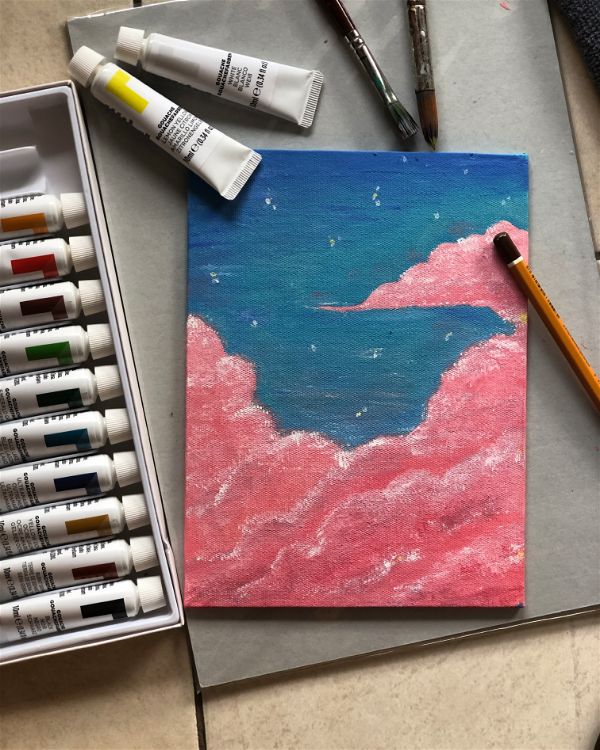
This fantasy sunset or sunrise sky I painted with gouache on a small canvas pad in around 45 minutes.
Sometimes gouache dries a bit darker, so don’t be afraid to test and experiment on a separate piece of paper with colors.
I only used blue, pink, yellow, and white to make this and it looks lovely! (At least I think so)
Sky paintings also introduce you to blending as you need to paint smooth transitions between colors and there are actually a few approaches to it that artists use both for acrylics and gouache, but I should say blending with gouache is much easier than with acrylic!
One of my tutorials also shows how to paint an easy night sky painting like this:
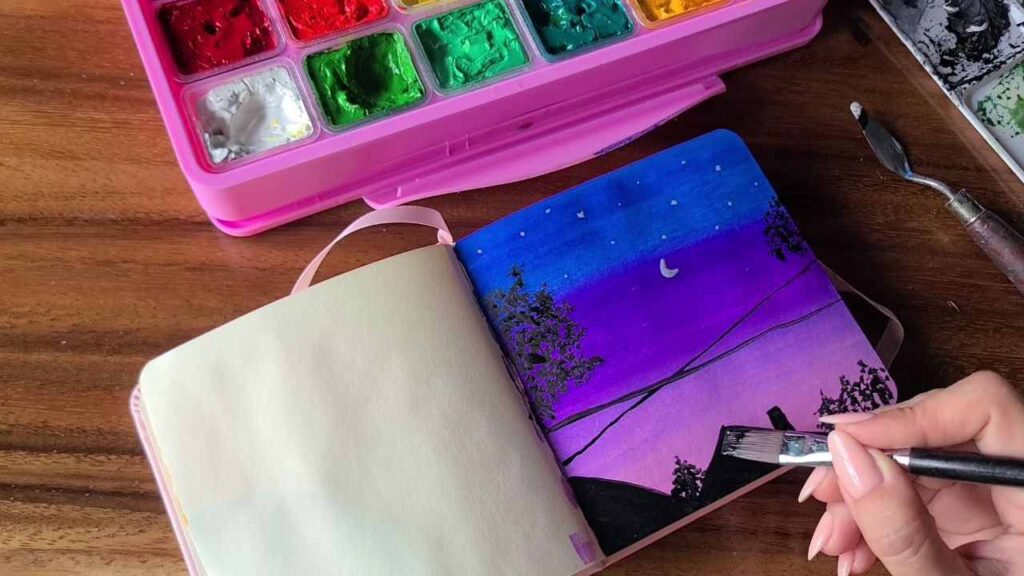
Bubbles
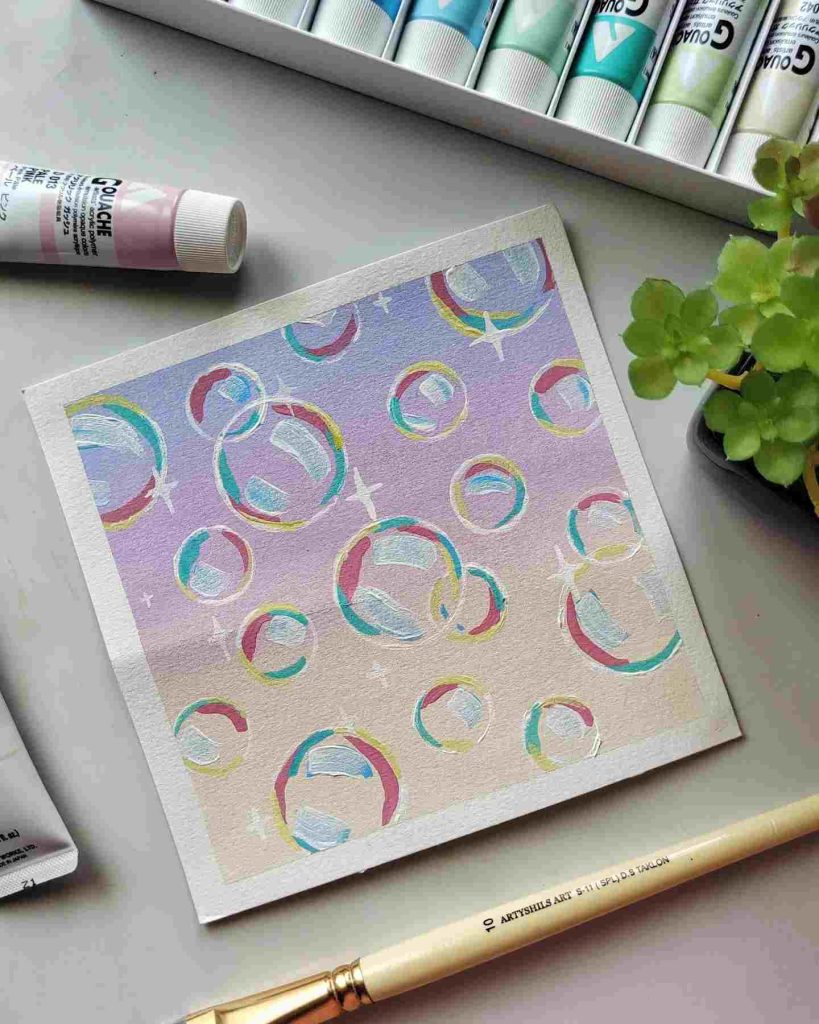
Easy to paint but good to learn more about transparent objects and how they actually hold so much colors in them and you need to work with reflections.
Motivational posters
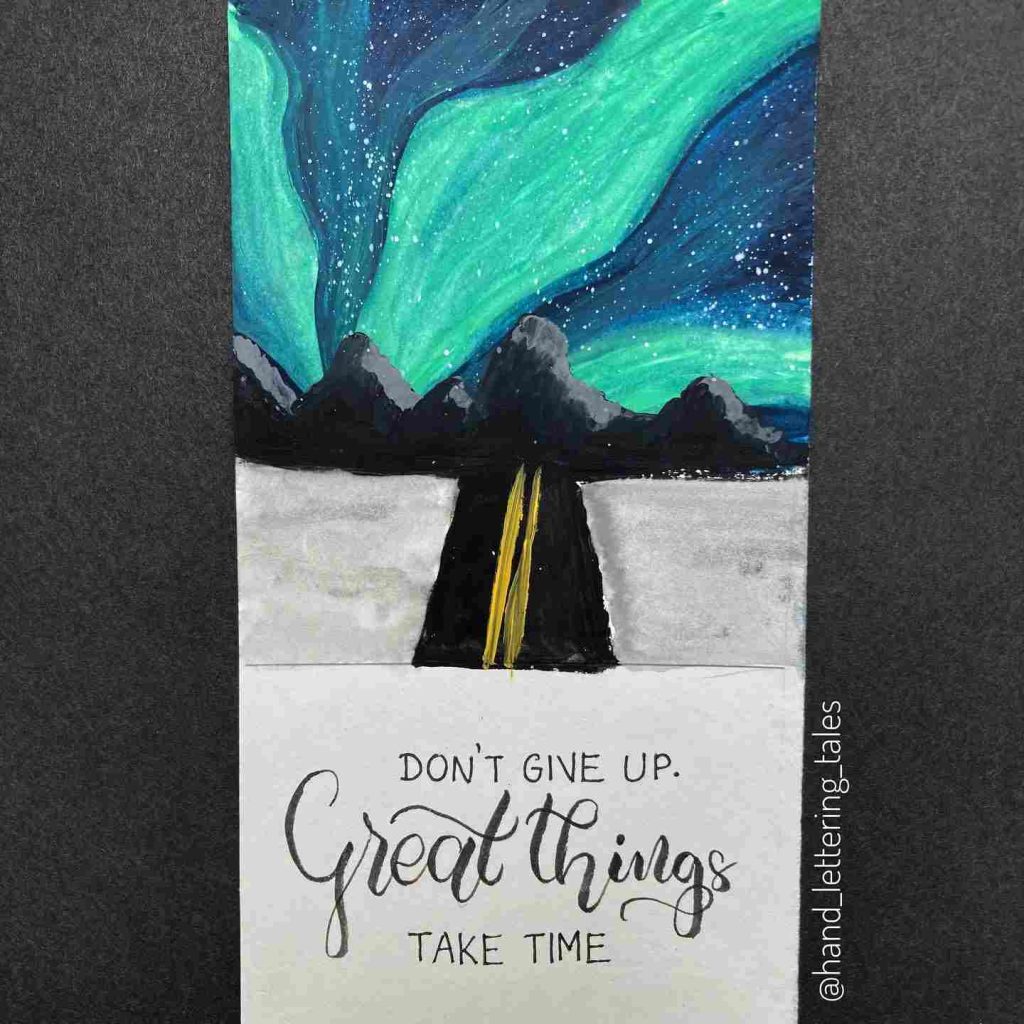
- Colors tend to attract more viewers than the actual painting, so creating a motivational poster with a lovely quote would engage them to read because of the soft colors and draw your attention daily to positive reminders.
- Use color wheel to decide what colors match or compliment each other or make rainbow 🙂
- For letters use markers.
Silhouettes
Painting a silhouette is one of the easiest options to do with any medium, including gouache. It looks very creative but saves you the headache of painting details, especially if we talk portraits or drawing humans 🙂
An excellent example:
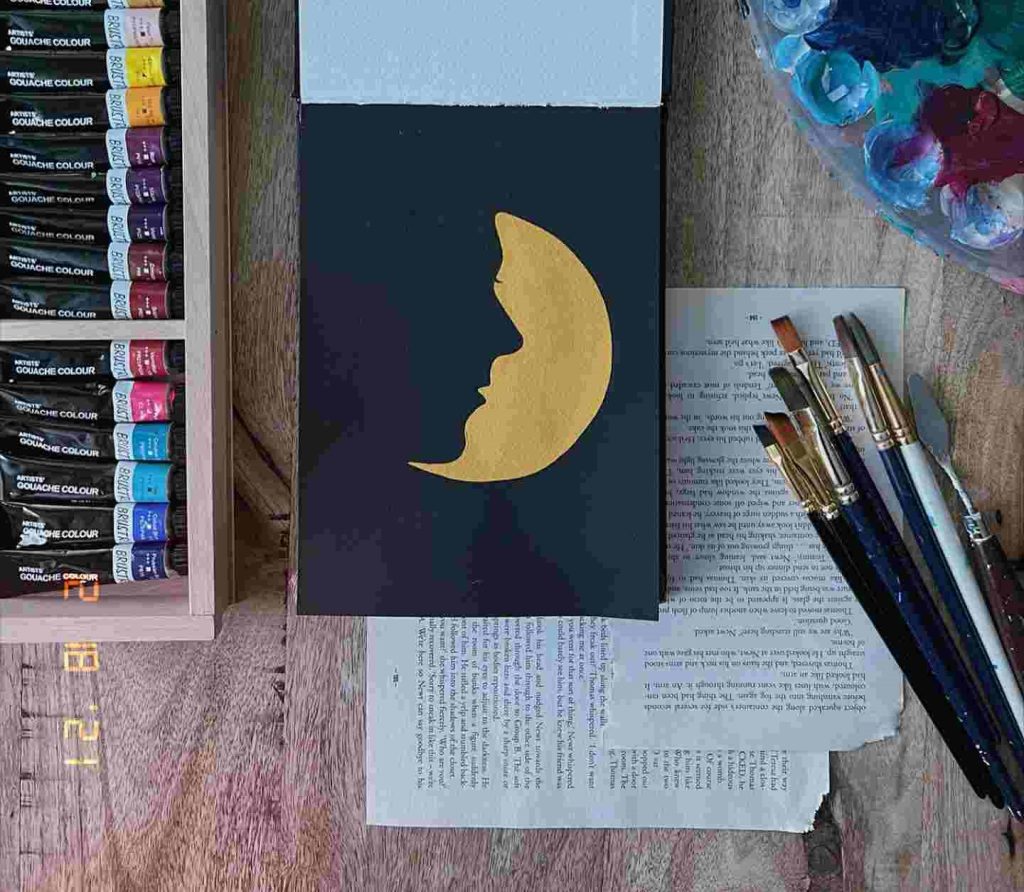
Starry night
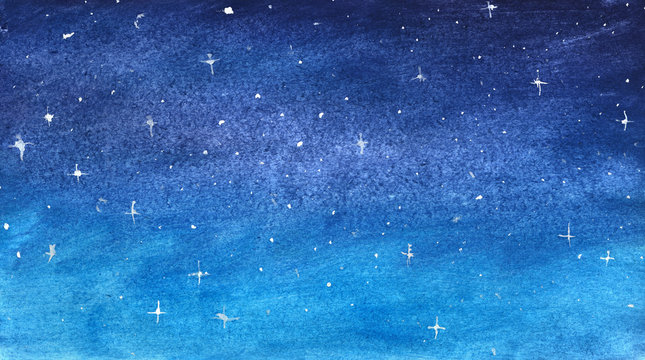
- Most of us love starry night skies, and painting with Gouache would make it more dreamy and peaceful. Nothing could be more aesthetically pleasing than the dark blue skies and purple clouds.
- Painting the night sky is easier than it looks but you may need some blending skills that are universal to gouache and acrylics.
- Prepare blue colors and purple or violet and apply them from top to bottom of your paper. Blend in between to make nice transitions.
- Add stars by using white paint on a toothbrush or paintbrush and splattering the paint or diligently paint each one of them 🙂
Looking for tutorials? Check these 22 Easy Night Sky Painting Tutorials (Acrylic, Watercolor, Poster Paint, Gouache)
Cloudy skies
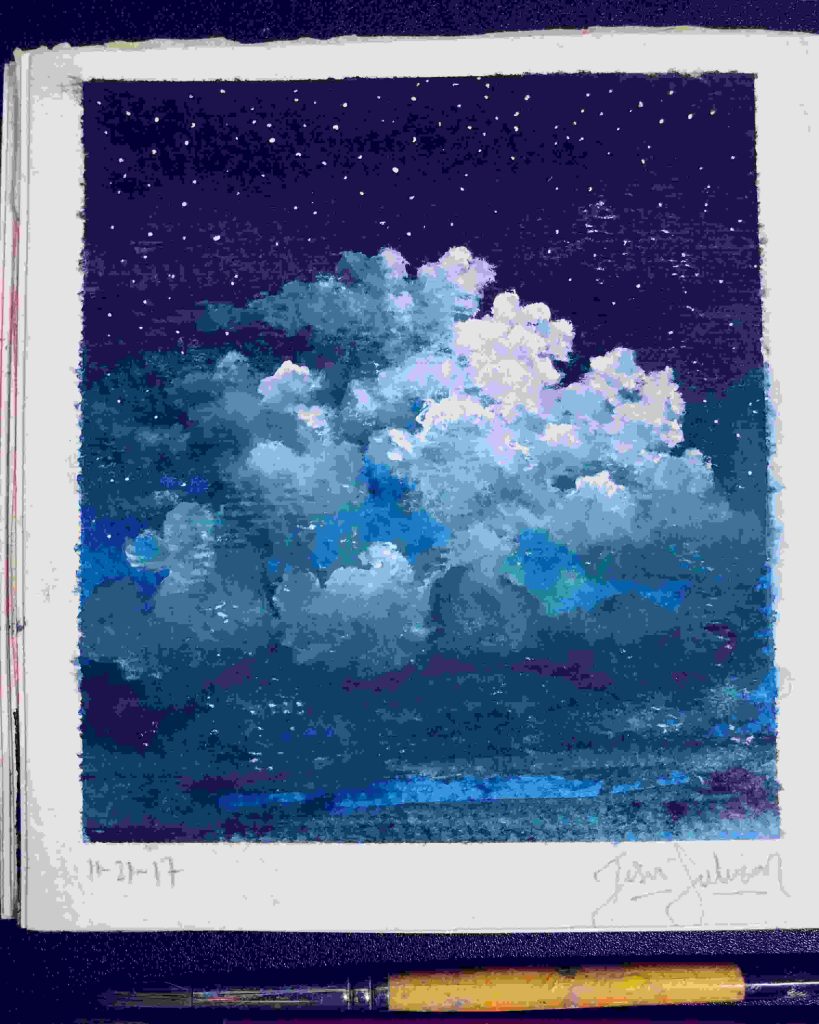
- Many people love the scenery of cloudy skies, flowers, and stars as they gaze through an artist’s painting. If other people love your work, you may be able to sell some of your pieces.
- Give your painting a field of depth with skies dominating most of the canvas but leave little space on the bottom for the little landscape to catch the viewer’s eye.
Looking for more tutorials? Check these How To Paint Stormy Sky 20 Great Tutorials For All Levels
Still life paintings
- Still life depicts inanimate objects, and some people prefer them over other forms of art. The peaceful and minimalistic aura it gives is enough to soothe and calm one’s mind.
- Experiment with color palettes and check what’s best for you and your painting; no pressure. Still life paintings are best when enjoyed while creating.
Self-portrait
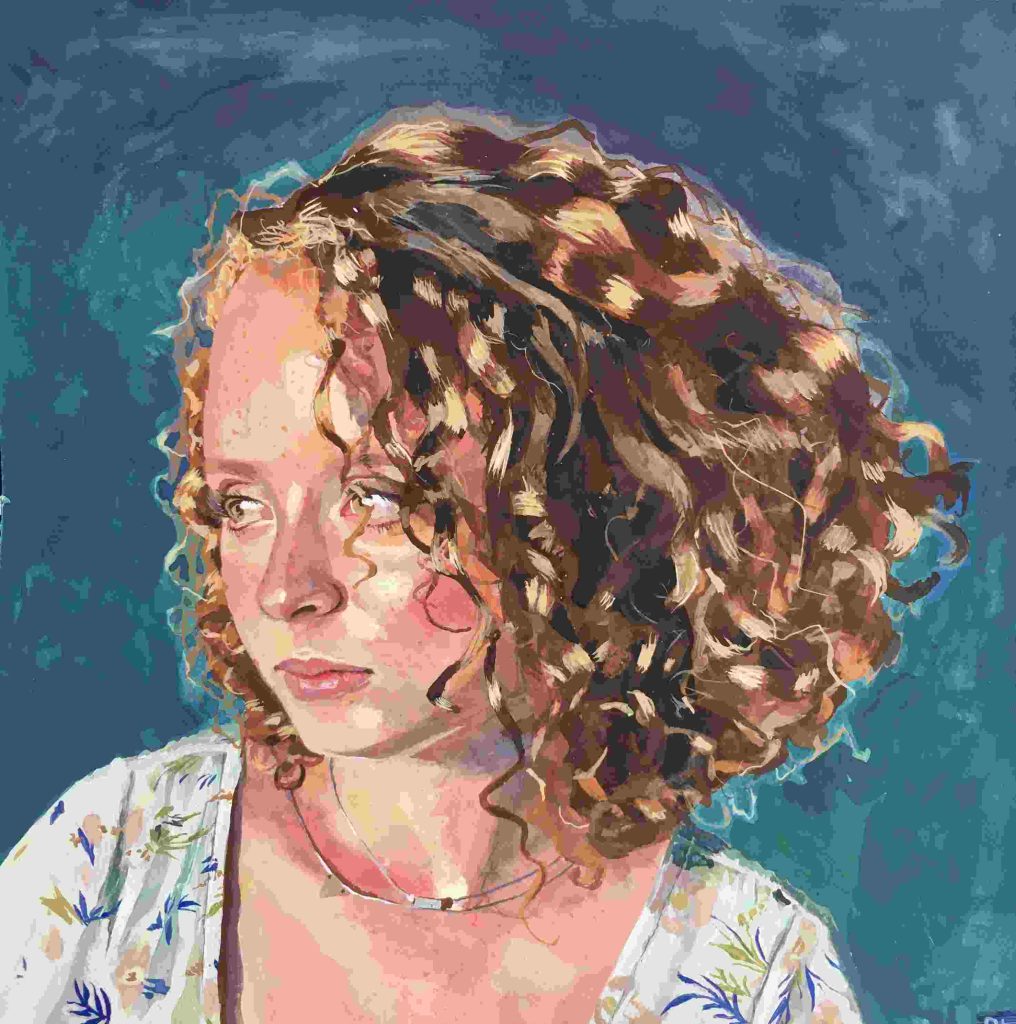
- Experiment with a graphical style, and eventually, you will learn how to paint yourself; practice makes perfect.
- Several illustrators from YouTube or their blogs will guide you through the process of painting your very own self-portrait. It requires more patience and skills but the results are truly rewarding.
Butterflies
One of the most beautiful creatures – butterflies are great painting idea as you can easily fantasize about colors of the wings and shapes. Or you can stick to real butterflies and use a photo as a reference.
A creative example:
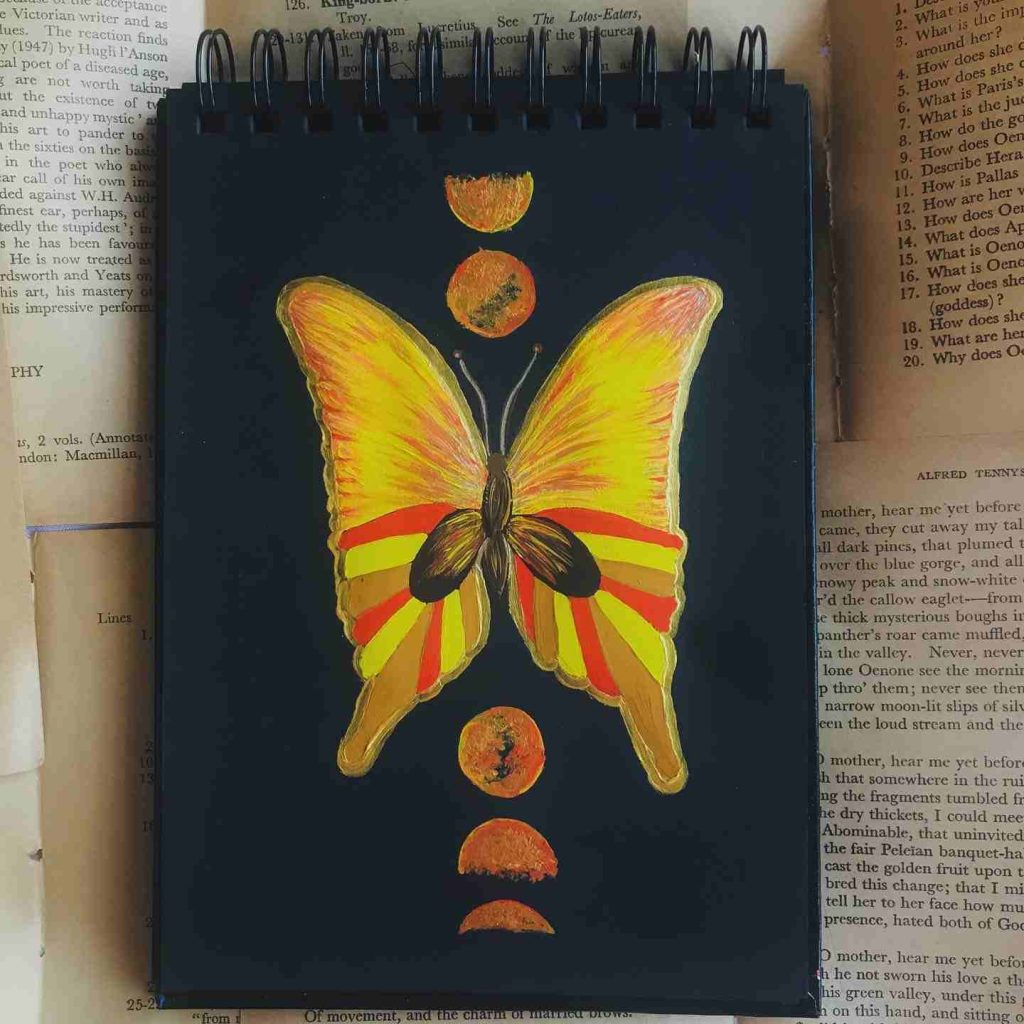
Field of flowers
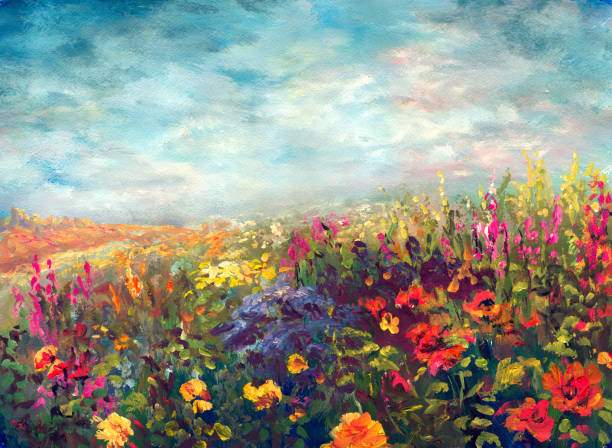
- Fields of flowers are engaging for most people, imagine driving down a straight road and you pass by a lot of beautiful, colorful flowers. That’s the feeling when you look at Gouache paintings.
- YouTube tutorials are available throughout, and they can guide you step-by-step on how to make an easy yet striking field of flowers as a painting.
Plants (including potted plants)
A great and simple gouache painting idea for home decor is to paint a plant in a pot, a succulent, a flower, a small palm, a ficus – anything!
Choose a smaller canvas or pad and buy a frame – done! You have I DIY home decor or a gift 🙂
Gouache Foliage
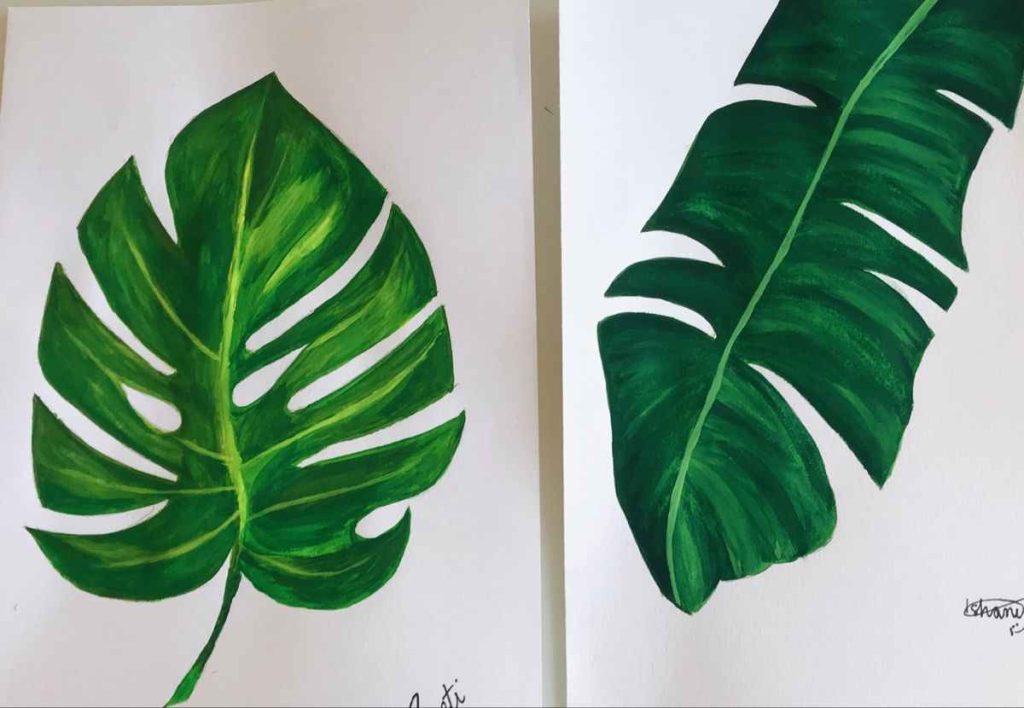
- Many artists use foliage as a starting point for their painting hobby or career. Professionals can also use it in all kinds of Gouache art as a part of detail.
- Googling can find tutorials and step-by-step procedures, and they will help beginners improve their art style and techniques for painting.
Midwinter Botanicals

- The gorgeous appearance of midwinter plants such as pinecones is majestic. Seeing them already gives many people Christmas feels and even gets them excited.
- Get the Christmas feels and paint midwinter botanicals, which are very friendly for beginners. If you know the basics of Gouache, it will be easy for you to paint such simple things.
Illustrative Landscapes
- One does not have to use realistic colors when painting landscapes; you can use other fun colors in nature to depict the abstract quality of your masterpiece.
- You can check out and explore different palettes to use and enjoy while painting your illustrative landscapes, skylines, or sceneries. It is up to you.
City
Landscapes, cities, food, and portraits can be styled as illustrations, like this:
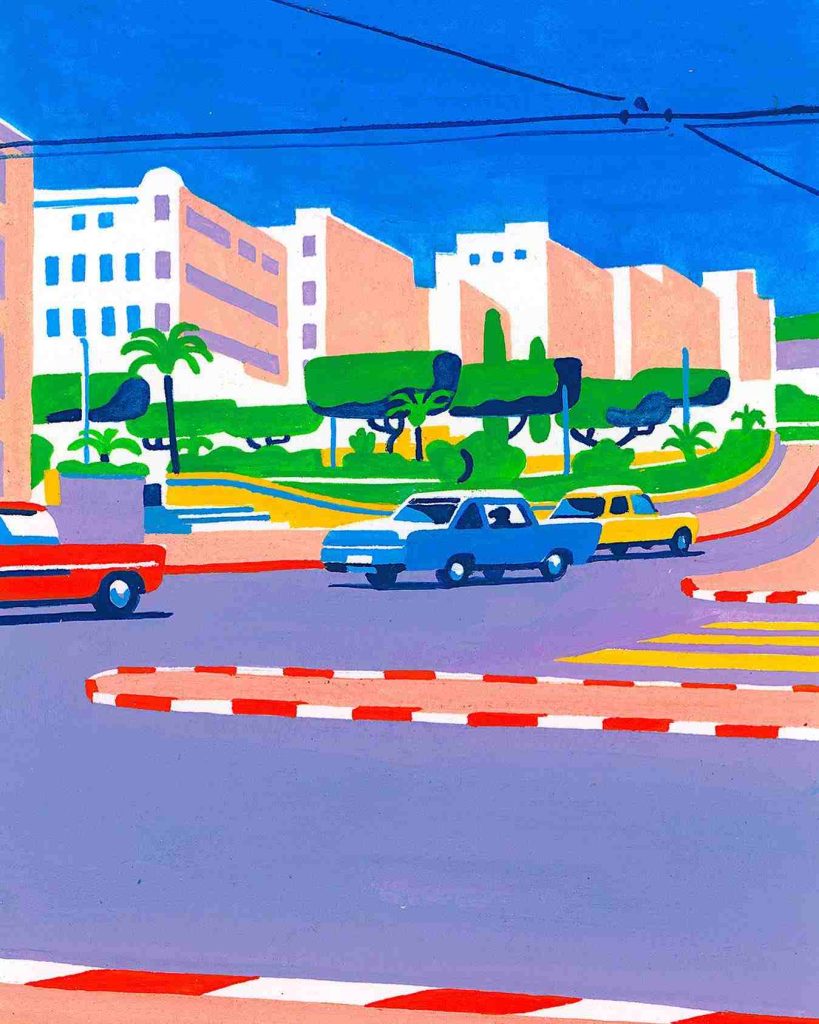
Seamless Patterns with Gouache
- Seamless patterns are highly flexible on any surface because they create interest in texture and flow. This method has been used for some time in fashion, product and package design, and it is swiftly gaining traction in other fields, especially graphic and online design. You can customize a postcard for your friends!
- Gouache works particularly well for laying down thick, saturated washes of color and that’s why more and more artists prefer it to acrylic for illustrations.
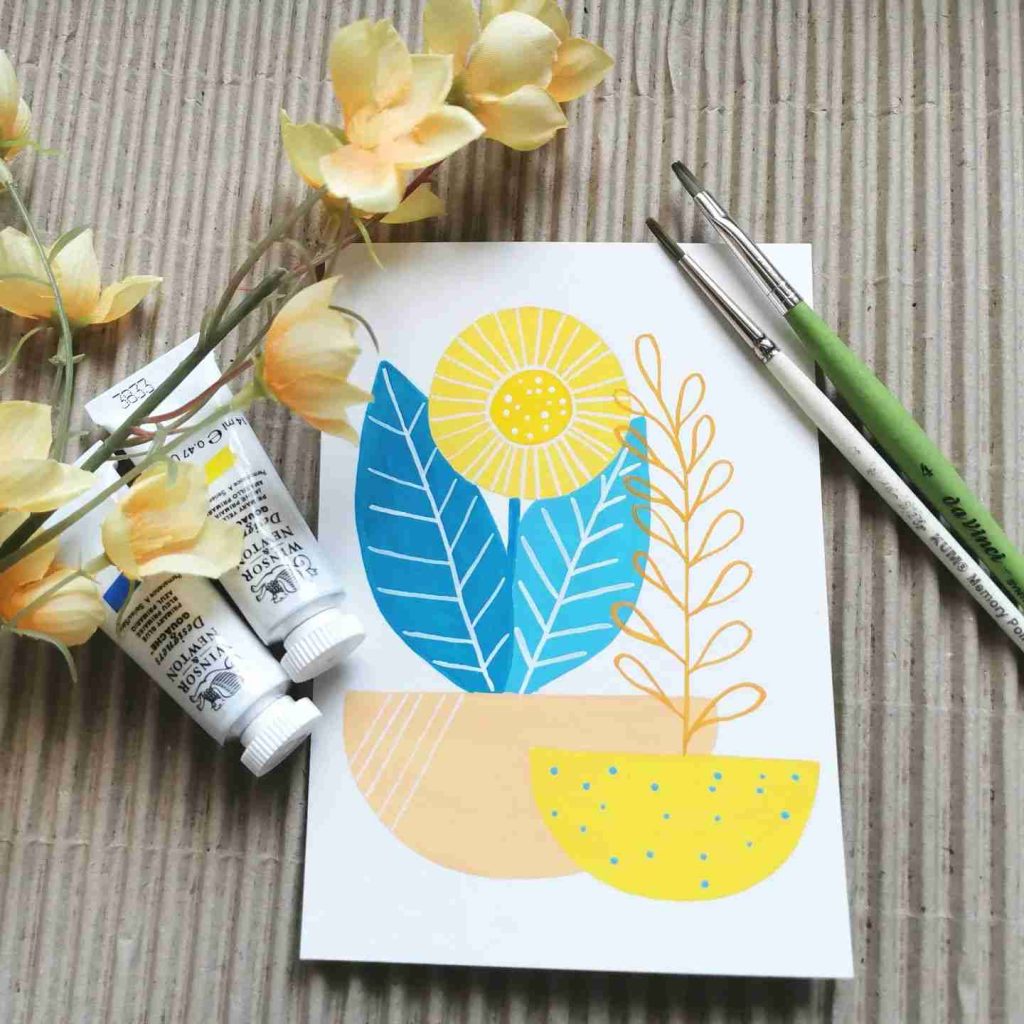
Flowers
Spring-themed gouache paintings often include flowers. Daisies, peonies, and violets are quite easy to paint!
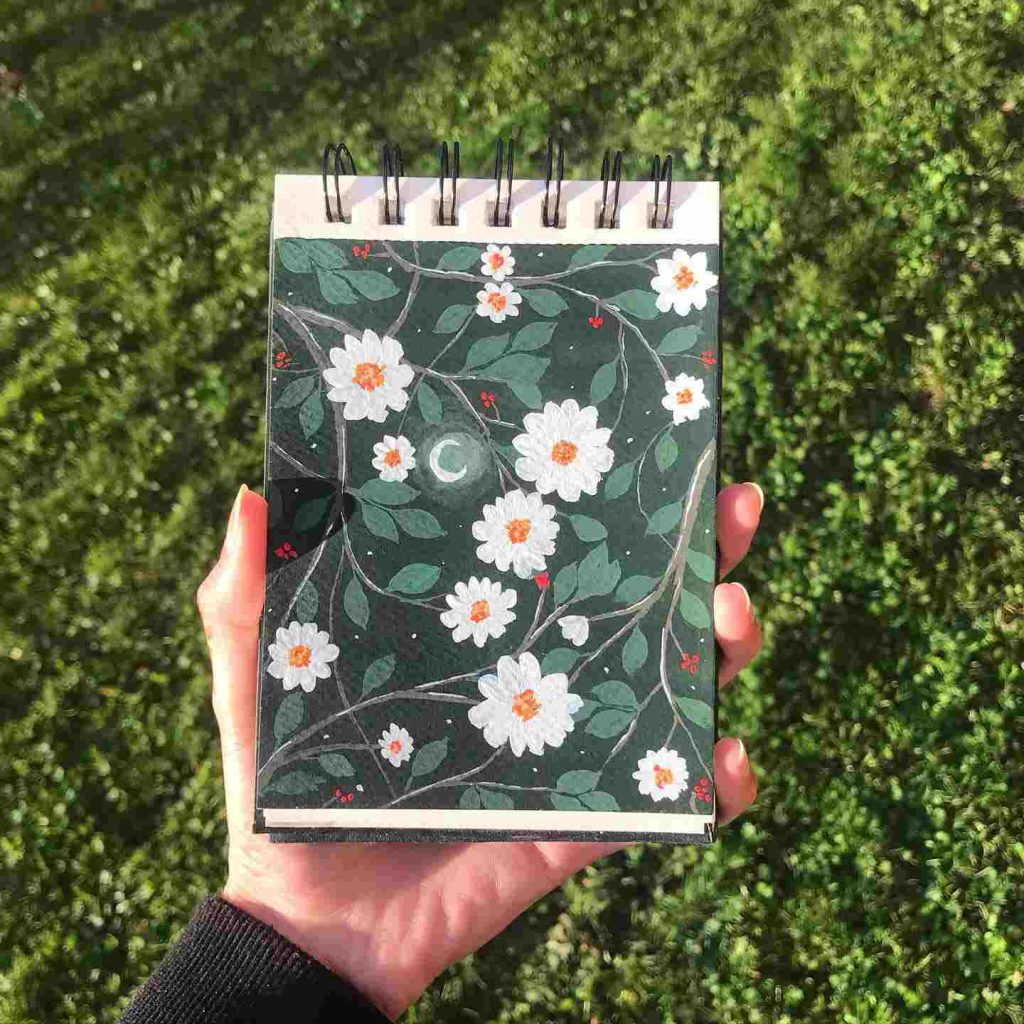
Looking for more tutorials to paint flowers? Check these How to Paint Peony 23 Beautiful Tutorials (Oil, Acrylic, Watercolor, Gouache)
Storefront Paintings
- When you look at storefronts from an artist’s perspective, they almost feel like individual “characters”. If you observe them closely, storefronts have many interesting details, from the structure itself to its decorations. These nuances are what shape a storefront’s identity – ideal for artwork. They often have Asian vibes but you can create Mediterranean storefronts easily!
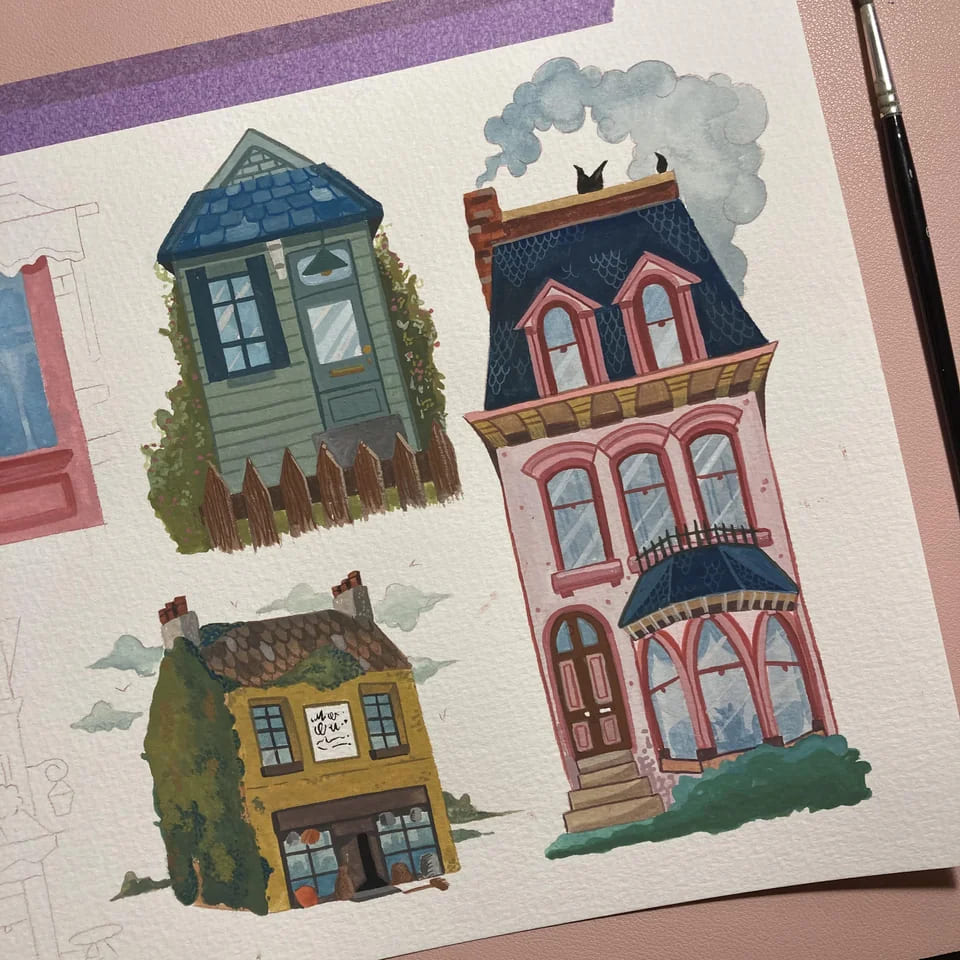
- Storefronts are generally made up of flat surfaces and bold colors, with gouache, you can easily lay consistent, vibrant colors down, making it one of the perfect mediums to use for this kind of artwork.
- Check out Mateusz Urbanowicz’s Tokyo Storefront series on YouTube for inspiration:
Anime Style Portraits
If you are an anime fan this one is for you!
- Gouache is an amazing medium for stylistic drawings. If you’re stuck in a rut, you can try to reimagine people’s portraits in the style of an anime character, or your own approach to anime.
- There are many ways to paint anime-style with gouache. For beginners, you can watch Rinspirit_art’s process on their anime-style portrait of Joshua from the popular now k-pop group Seventeen:
Fanart
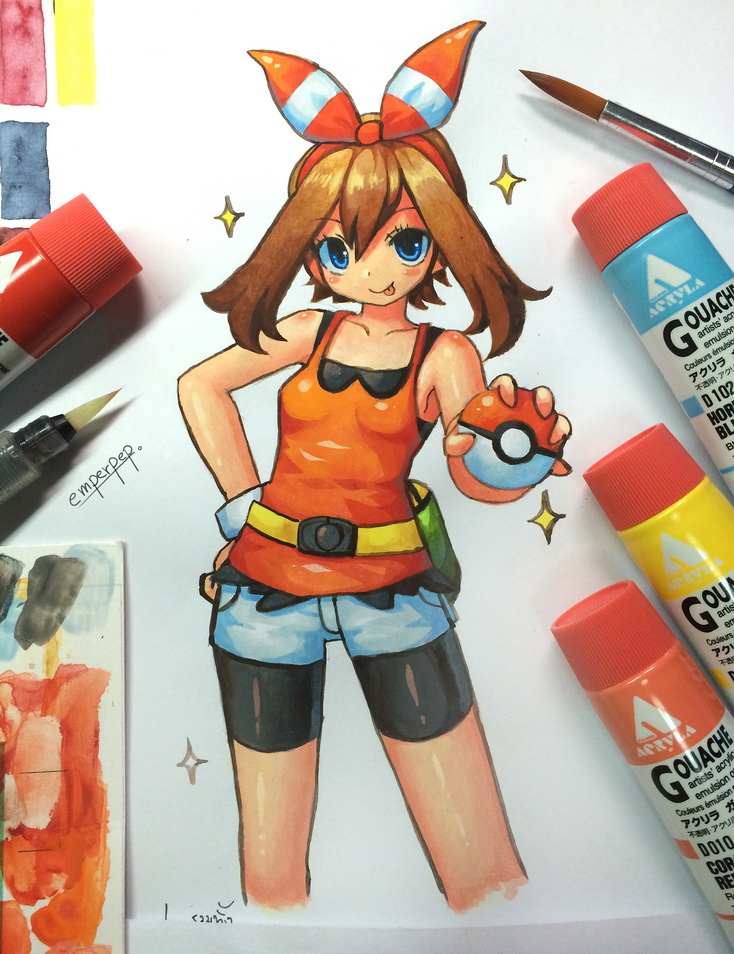
- Fan art provides an outlet for fans to express their love or continue their immersion in their favorite shows and characters outside the canon of the original media. Thanks to fan art, artists can establish meaningful relationships with other people within the same fandom community.
- You’ve probably already seen a ton of fan art of animated characters if you’ve spent a lot of time on social media. If you want to choose a stylistic approach in your artwork, you can emulate the vibrant, cell-shaded rendering approach commonly found in digital artworks using gouache paints. Artist Sara Fabrizi on YouTube gives a great example for this approach. 🌷 Paint with me // ft. Arteza Gouache 💗
Anime Screenshot Redraw
I don’t know about you but when I was a little girl I looooved Sailor Moon even though I understood like 30% of what I saw and my mom was completely against me watching this cartoon haha, but back to our painting lessons – you can paint your fav character with gouache!
hard to balance anime style with detail/realism but this was fun! #sailormoonredrawchallenge #sailormoonredraw pic.twitter.com/zB7cVI1ety
— yue (@yueko__) May 19, 2020
- This trend took over the art community by storm in 2020, if you spent enough time on Twitter, you might remember the popular “Sailor Moon Redraw Challenge” in which artists from all over the world participated in this trend and made their own take of the chosen Sailor Moon screenshot. While this kind of art is not news, it has reached the online mainstream, giving a resurgence to other screenshot challenges in the following years.
- If you’re experiencing art block, you can participate in recent or old challenges to warm up. Obviously, joining isn’t necessary, you can always pick your own screenshots from your favorite shows (whether it is animated or live-action), recreate them in your style, and perhaps, make your own redraw challenge from that.
Ghibli Scene Recreation
Level: Advanced
- Following the popularity of the Sailor Moon challenge, another viral trend has sailed the art community. Twitter user Kadeart challenged artists to reimagine Studio Ghibli’s iconic scenes in their own art style. Studio Ghibli is home to successful animated movies in the industry such as “My Neighbor Totoro”, “Howl’s Moving Castle”, and “Spirited Away”, becoming certified childhood classics for many because of their whimsical themes. You can view the artists’ entries under the hashtag “#GhibliRedraw”.
- This is another fun way to practice your gouache painting skills. Artist YouTuber Jenny Xia uploaded the layering process of their redraw of a scene in Kiki’s Delivery Service, and you can really see how Ghibli’s vibrant scenes can be beautifully recreated with gouache.
One more gouache painting from a Ghibli movie by u/umbrella_artist on Reddit:
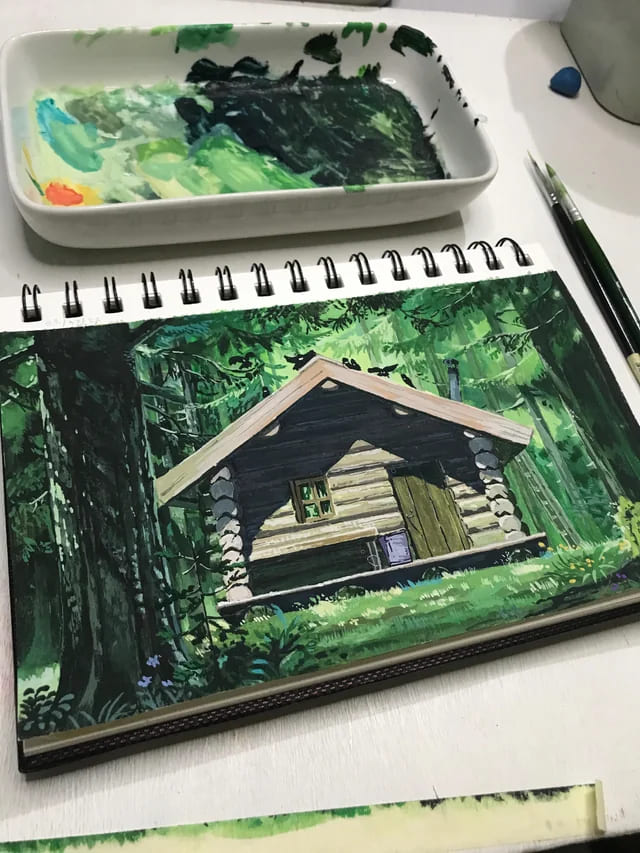
Travel Journals
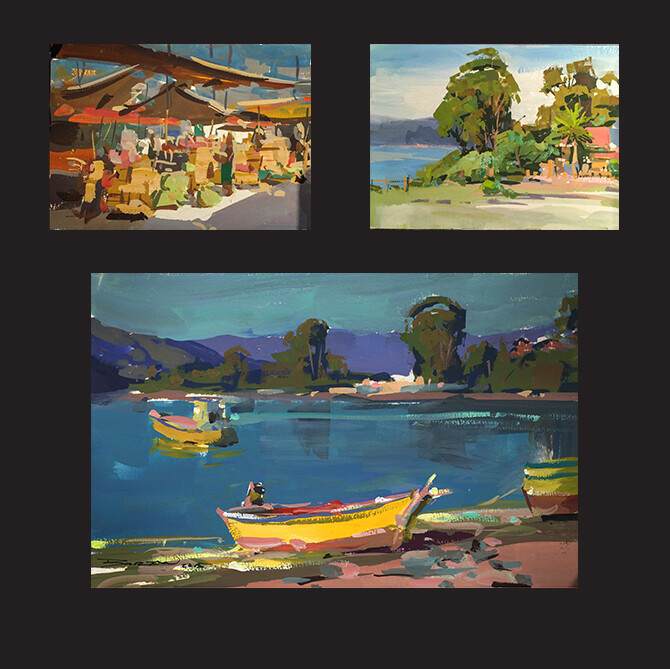
- Keeping a travel journal is a way for artists to express their creativity while documenting their travel experiences. Bring your own unique aesthetic or create one as you explore various creative techniques. You will most likely need a travel gouache paint set and a travel brush that are compact.
- Of course, you don’t have to limit your paintings to landscapes. You can bring life to your own travel journals by illustrating food (food illustrations are, personally, my favourite gouache painting ideas), statues, ornaments, structures, etc. I really love doors in some European old cities. Here is a great example by a fellow artist:
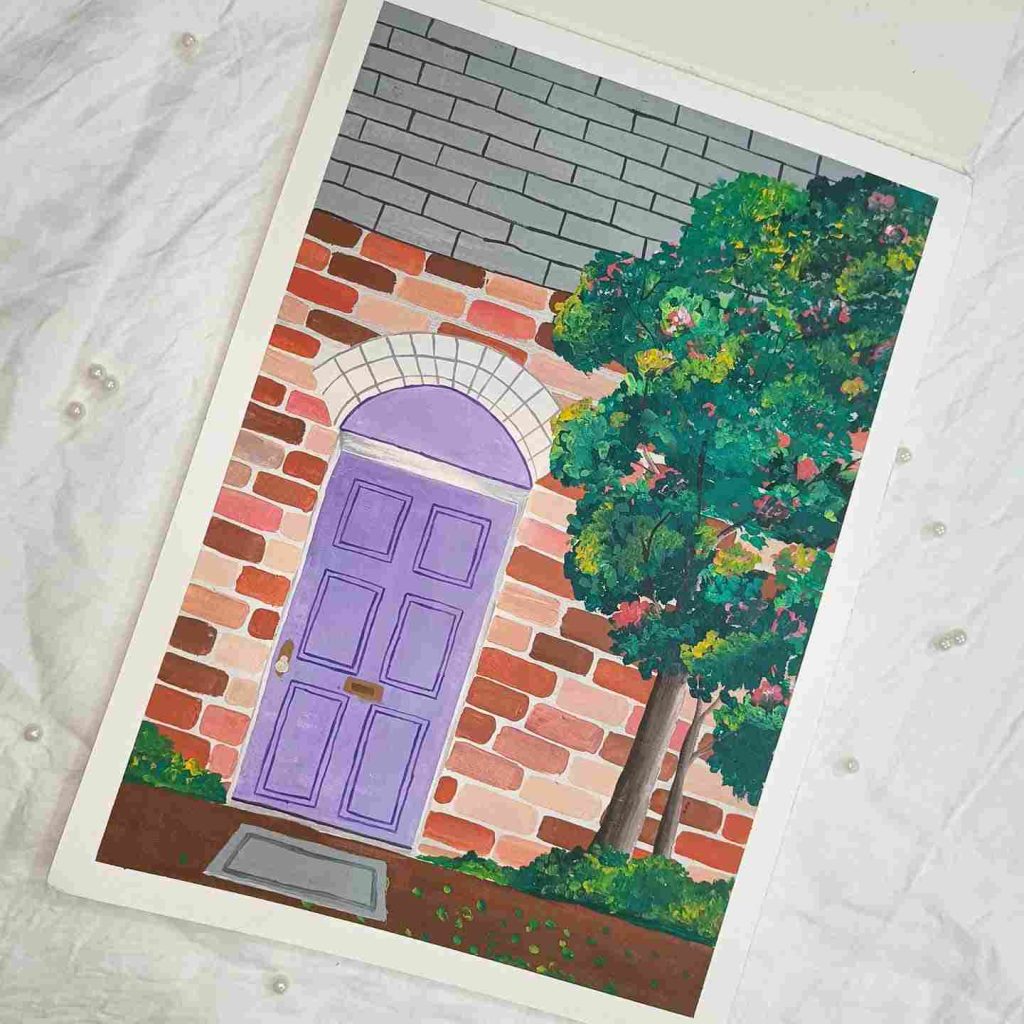
Food Illustrations
- Food Illustrations are an individual’s creative visual interpretations of any food or drink. If you’re a food enthusiast, you also give yourself exposure to learning about dishes you haven’t seen before by researching other cultural dishes.
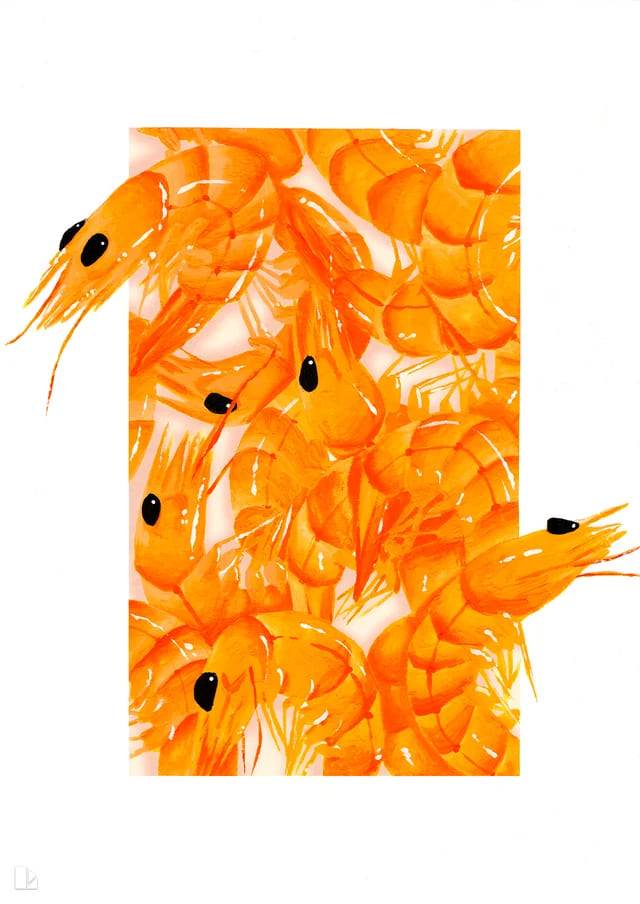
- These types of illustrations make the dish more enticing to look at, by enhancing the qualities of a dish with graphically appealing elements. Gouache paints are perfect for food illustrations because you can depict dishes opaque and saturated, making them even more attractive to look at. Artists can learn a lot by drawing different types of food, the subject may be simple, but you have to play around with interesting shape languages to achieve an even more appetizing illustration.
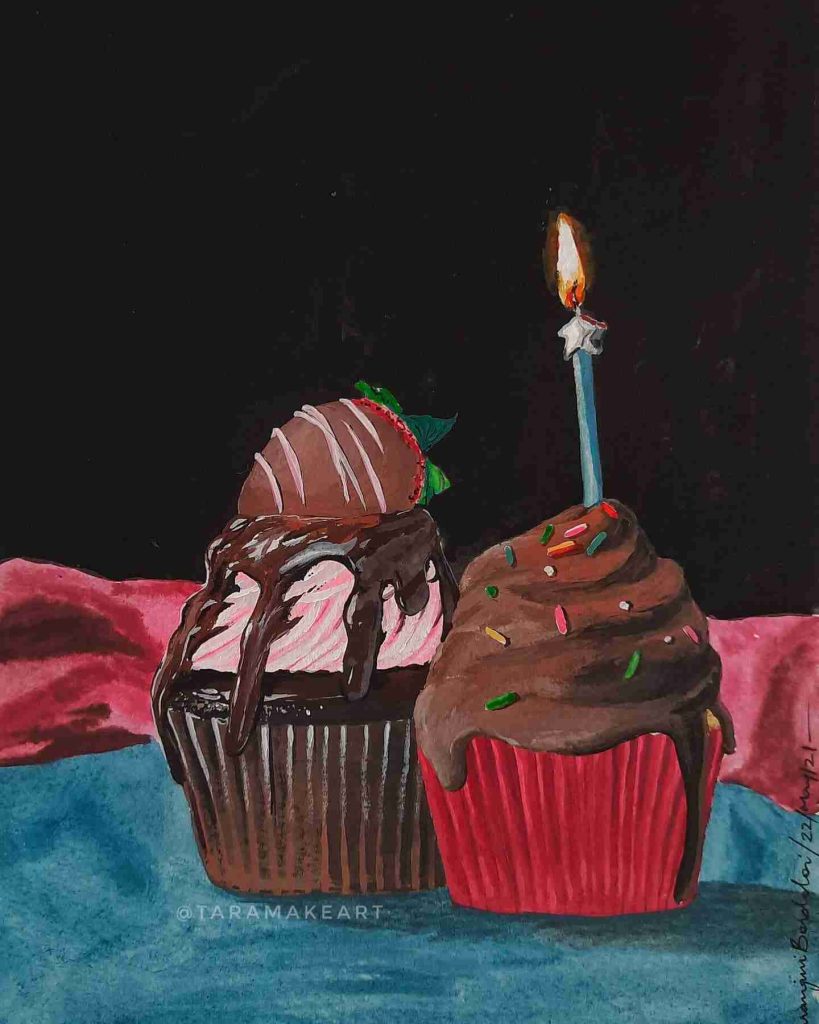
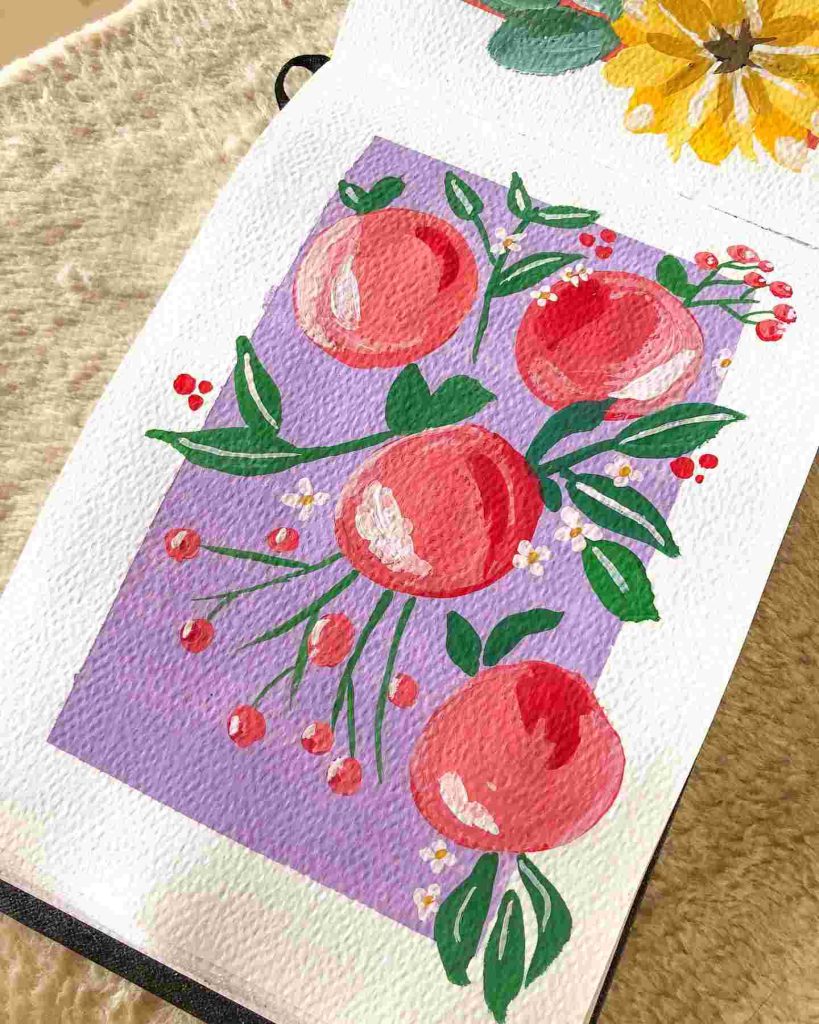
Master Studies
- Learning from the Master is part of an artist’s journey. By recreating a painting of an experienced artist, you will learn to discern their artistic process and learn new techniques along the way.
- If you’re using gouache for the exercise, pay closer attention to the shape language and values of the painting. Since one of the downsides of using gouache is its interaction with water, you need to challenge yourself to recreate them with gouache techniques and layering.
Limited Palette Challenge
- In limited palette challenges, you either make your own artwork or copy from a reference and limit your color choices between a few swatches of different values belonging to the same color harmony. The purpose of this challenge is to improve the artist’s perception of values and actually explore colors and color mixing.
- Since you’ll be dealing with a lot of bold, flat washes of colors, you’ll have an easier time doing this challenge with gouache. You just have to identify which shade is appropriate to use.
Animal Stickers with Gouache
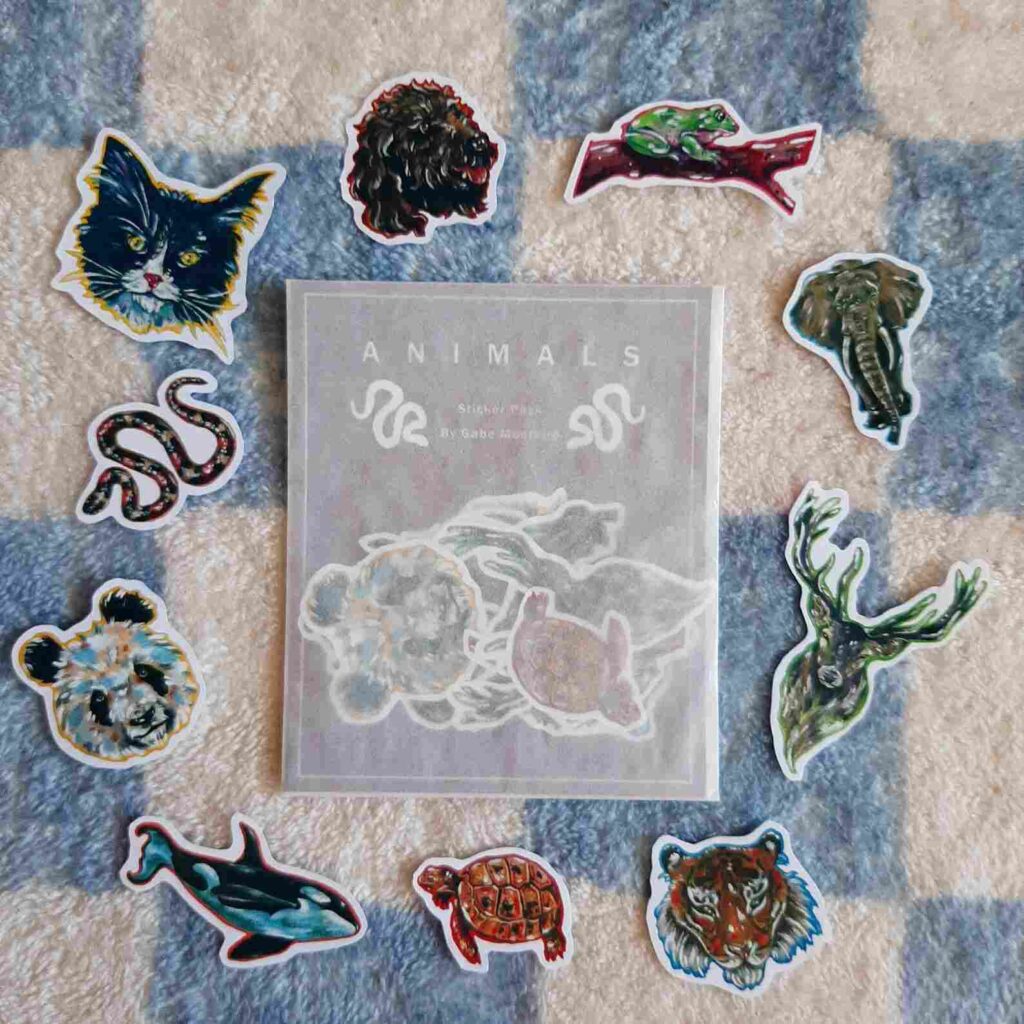
- Everyone’s got their own favorite animal, and some would even love to have a sticker of them displayed on their journal, phone, or laptop. So here’s a fun DIY project for yourself or for a business: animal stickers!
- As said before, gouache paints have the qualities of being flat and opaque, which makes them ideal for scanning. If you enjoy painting traditionally and want to make stickers or prints out of them, using gouache is a great option.
Gouache Plein Air Painting
This is my 1st plein air painting with gouache.
— YoichiNishikawa/西川洋一 (@YohIchi_N) March 31, 2019
It was too hard to paint for me… pic.twitter.com/zpIw3czXM6
- To paint “en plein air,” a French word meaning “in the open air,” means to paint outside, with the landscape within the artist’s plain sight. It is through the use of natural light, color, and movement that plein air painters are able to capture the essence of a scene or subject.
- Any medium is fine for painting outdoors, but gouache is a wonderful choice because it is water-soluble and dries quickly. You can watch some useful tutorials from James Gurney, who has made a lot of plein-air paintings using gouache.
The ideas listed above are some of the simplest yet most fabulous painting ideas you could try, but remember to enjoy every single bit of your Gouache painting experience so you can be motivated in the future.
When you finished your masterpiece you can protect the paint from fading and UV by simply varnishing it just like acrylic painting but this is completely optional. You can skip varnishing if you are not sure how to do it and your painting will be just fine 🙂
When an artist paints, they should cherish every stroke they make and every mix they do in the palette they hold, and it’s a gift to have such a talent.
We are hoping for the best in your future art pieces, as we may have helped you think of a good idea to start your painting with. Many famous artists would also use ideas from someone else, so don’t be ashamed.
Looking to upskill? Check these 23 Top Gouache Painting Tips & Secrets From Pros
Final Word
Gouache is an excellent medium to practice, and artists recommend mixing it with other media, such as acrylic paint and watercolor, to create hybrid mixtures and different paints and characteristics.
Check also: 16 Most Famous Gouache Paintings
Landscapes, portraits, easy drawings, watercolor-like washes, skies, animals, kids’ paintings – everything is possible with gouache. Gouache is commonly for mini canvas and paper paintings of landscapes and illustrations, especially with limited and pastel palettes.
Gouache is easy to get along with; it’s like making friends or riding a bicycle. Once you get used to it, you can do it repetitively.
Don’t be afraid to use Gouache; it is beginner-friendly and easy to clean.
For years, many artists practiced painting with other media, but Gouache eventually came to them and evolved their careers; the paint is beneficial for illustrations and the artist.
Whether you’re a pro or a newbie, Gouache offers techniques that could widen your horizons as a painter, and with these ideas, I hope you have indeed explored your preferred painting style.
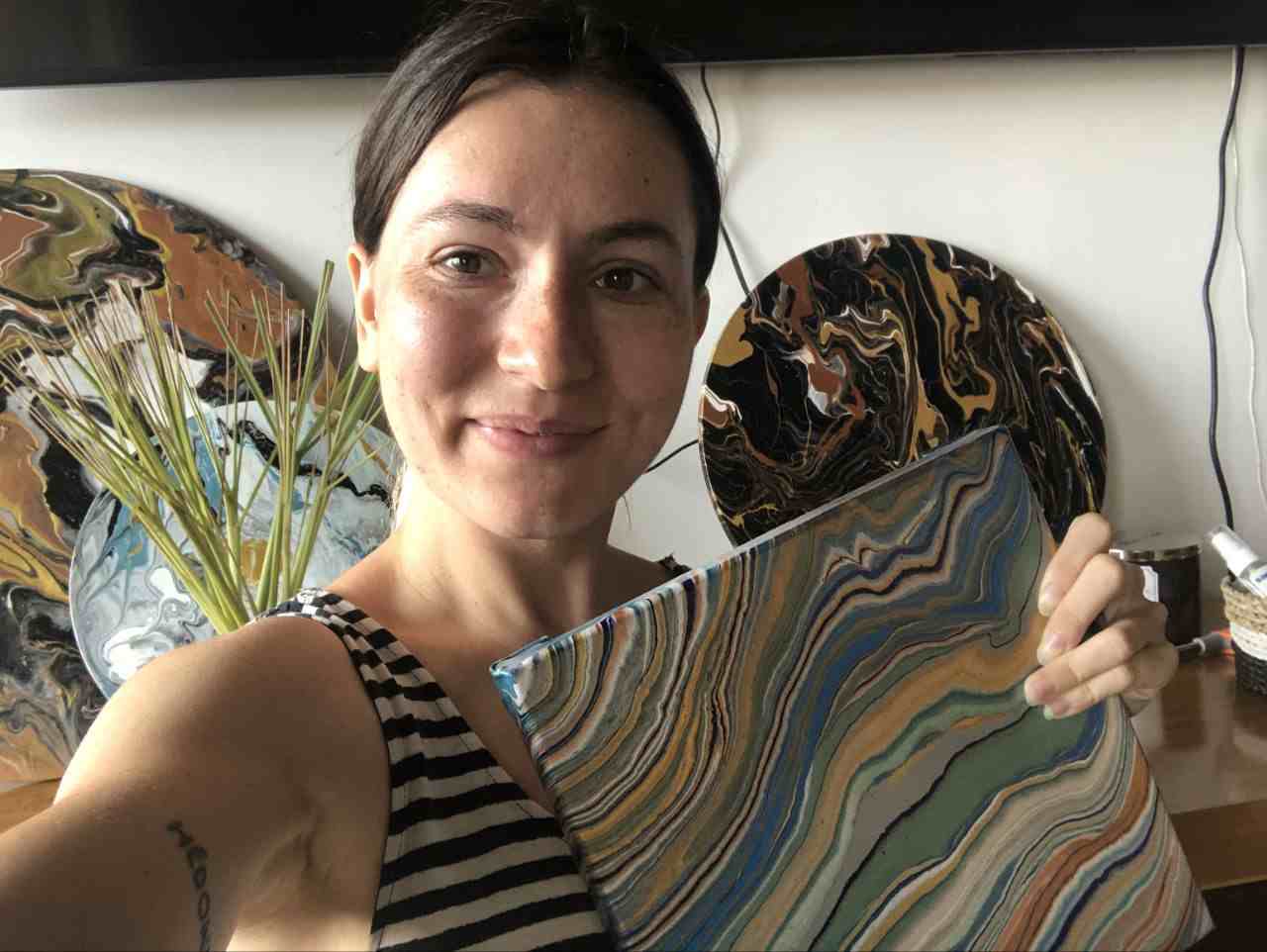
Masha Eretnova, born in 1991, is a Buenos Aires-based certified teacher, artist, and member of the Professional Artist Association with 20+ years of personal painting journey.
She started painting and drawing very early and is now an international abstract artist and educator passionate about acrylic painting, gouache, and crafts.
Her works are part of international exhibitions and contests, including ArtlyMix (Brazil), Al-Tiba 9 (Spain), Exhibizone (Canada), Italy, and many more.
Besides her artistic pursuits, Masha holds a post-grad diploma in Teaching Film Photography and 2 music school diplomas: piano and opera singing.
